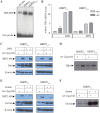Tumorigenic properties of iron regulatory protein 2 (IRP2) mediated by its specific 73-amino acids insert
- PMID: 20405006
- PMCID: PMC2854138
- DOI: 10.1371/journal.pone.0010163
Tumorigenic properties of iron regulatory protein 2 (IRP2) mediated by its specific 73-amino acids insert
Abstract
Iron regulatory proteins, IRP1 and IRP2, bind to mRNAs harboring iron responsive elements and control their expression. IRPs may also perform additional functions. Thus, IRP1 exhibited apparent tumor suppressor properties in a tumor xenograft model. Here we examined the effects of IRP2 in a similar setting. Human H1299 lung cancer cells or clones engineered for tetracycline-inducible expression of wild type IRP2, or the deletion mutant IRP2(Delta73) (lacking a specific insert of 73 amino acids), were injected subcutaneously into nude mice. The induction of IRP2 profoundly stimulated the growth of tumor xenografts, and this response was blunted by addition of tetracycline in the drinking water of the animals, to turnoff the IRP2 transgene. Interestingly, IRP2(Delta73) failed to promote tumor growth above control levels. As expected, xenografts expressing the IRP2 transgene exhibited high levels of transferrin receptor 1 (TfR1); however, the expression of other known IRP targets was not affected. Moreover, these xenografts manifested increased c-MYC levels and ERK1/2 phosphorylation. A microarray analysis identified distinct gene expression patterns between control and tumors containing IRP2 or IRP1 transgenes. By contrast, gene expression profiles of control and IRP2(Delta73)-related tumors were more similar, consistently with their growth phenotype. Collectively, these data demonstrate an apparent pro-oncogenic activity of IRP2 that depends on its specific 73 amino acids insert, and provide further evidence for a link between IRPs and cancer biology.
Conflict of interest statement
Figures







References
-
- Rouault TA. The role of iron regulatory proteins in mammalian iron homeostasis and disease. Nat Chem Biol. 2006;2:406–414. - PubMed
-
- Muckenthaler MU, Galy B, Hentze MW. Systemic iron homeostasis and the iron-responsive element/iron-regulatory protein (IRE/IRP) regulatory network. Annu Rev Nutr. 2008;28:197–213. - PubMed
Publication types
MeSH terms
Substances
Grants and funding
LinkOut - more resources
Full Text Sources
Medical
Research Materials
Miscellaneous

